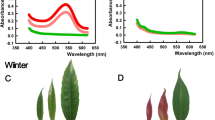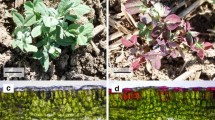Abstract
The effect of anthocyanic cells of the epidermal layer was investigated on photosynthetic activity of the higher plant Tradescantia pallida. To determine the possible indirect role of anthocyanin in photosynthesis, analysis was done on intact leaves and leaves where anthocyanic epidermal layer was removed. Energy dissipation processes related to Photosystem II (PSII) and Photosystem I (PSI) activity was done using simultaneously Chlorophyll a (Chl a) fluorescence and P700 transmittance signals change. In anthocyanic epidermal-less leaves, PSII photochemical activity was more decreased in dependence to increasing light irradiance exposure. We found that photoinhibition of PSII decreased PSI activity by reducing the electron flow toward PSI, especially under high light intensities. Under those conditions, it resulted in the accumulation of oxidized PSI reaction centers, which was stronger in leaves where the anthocyanic epidermal layer was removed. In conclusion, our results showed that the anthocyanic epidermal layer had a photoprotective effect only on the PSII and not on the PSI of T. pallida leaves, supporting the role of anthocyanin pigments in the regulation of photosynthesis for excess absorbed light irradiance.






Similar content being viewed by others
Abbreviations
- Chl:
-
Chlorophyll
- ETRI:
-
Electron transport rate of PSI
- ETRII:
-
Electron transport rate of PSII
- LHC:
-
Light-harvesting complexes
- PSI:
-
Photosystem I
- PSII:
-
Photosystem II
- UV:
-
Ultraviolet
- ΦMII:
-
Maximum PSII quantum yield
- \( \Upphi_{\text{M}}^{\prime } {\text{I}} \) :
-
Operational quantum yield of PSI
- \( \Upphi_{\text{M}}^{\prime } {\text{II}} \) :
-
Operational quantum yield of PSII
- \( \Upphi_{\text{NPQ}}^{\prime } \) :
-
Quantum yield for regulated non-photochemical energy dissipation of PSII
- \( \Upphi_{\text{NO}}^{\prime } \) :
-
Quantum yield for non-regulated non-photochemical energy dissipation of PSII
- \( \Upphi_{\text{NA}}^{\prime } \) :
-
Quantum yield for non-photochemical energy dissipation caused by acceptor side limitation of PSI
- \( \Upphi_{\text{ND}}^{\prime } \) :
-
Quantum yield for non-photochemical energy dissipation caused by donor side limitation of PSI
References
Burger J, Edwards GE (1996) Photosynthetic efficiency, and photodamage by UV and visible radiation, in red versus green leaf coleus varieties. Plant Cell Physiol 37:395–399
Chalker-Scott L (1999) Environmental significance of anthocyanins in plant stress responses. Photochem Photobiol 70:1–9
Genty B, Briantais JM, Baker NR (1989) The relationship between the quantum yield of photosynthetic electron transport and quenching of chlorophyll fluorescence. Biochim Biophys Acta 990:87–92
Gould KS, Kuhn DS, Lee DW, Oberbauer SF (1995) Why leaves are sometimes red. Nature 378:241–242
Harbinson J, Foyer CH (1991) Relationships between the efficiencies of photosystems I and II and stromal redox state in CO2-free air. Plant Physiol 97:41–49
Harbinson J, Hedley CL (1993) Changes in P-700 oxidation during the early stages of the induction of photosynthesis. Plant Physiol 103:660–694
Harbinson J, Genty B, Baker NR (1989) Relationship between the quantum efficiencies of Photosystems I and II in Pea leaves. Plant Physiol 90:1029–1034
Herde O, Peña-Cortés H, Fuss H, Willmitzer L, Fisahn J (1999) Effects of mechanical wounding, current application and heat treatment on chlorophyll fluorescence and pigment composition in tomato plants. Physiol Planta 105:179–184
Hope AB, Valente R, Matthews DB (1994) Effects of pH on the kinetics of redox reactions in and around the cytochrome bf complex in an isolated system. Photosynth Res 42:111–120
Iwashina T (2000) The structure and distribution of the flavonoids in plants. J Plant Res 113:287–299
Kitajima M, Butler WL (1975) Quenching of chlorophyll fluorescence and primary photochemistry in chloroplasts by dibromothymoquinone. Biochim Biophys Acta 376:105–115
Kitajima K, Hogan KP (2003) Increases of chlorophyll a/b ratios during acclimation of tropical woody seedlings to nitrogen limitation and high light. Plant, Cell Environ 26:857–865
Klughammer C, Schreiber U (1991) Analysis of light-induced absorbance changes in the near infra-red spectral region. I. Characterization of various components in isolated chloroplasts. Z Naturforsch 46c:233–244
Klughammer C, Schreiber U (1994) An improved method, using saturating light pulses, for the determination of Photosystem I quantum yield via P700+—absorbance changes at 830 nm. Planta 192:261–268
Klughammer C, Schreiber U (2008a) Saturation pulse method for assessment of energy conversion in PSI. PAM Appl Notes 1:11–14
Klughammer C, Schreiber U (2008b) Complementary PSII quantum yields calculated from simple fluorescence parameters measured by PAM fluorometry and the saturation pulse method. PAM Appl Notes 1:27–35
Kramer DM, Johnson G, Kiirats O, Edwards GE (2004) New fluorescence parameters for the determination of QA redox state and excitation energy fluxes. Photosynth Res 79:209–218
Lichtenthaler HK (1987) Chlorophylls and carotenoids: pigments of photosynthetic biomembranes. Method Enzymol 148:350–382
Mancinelli AL, Rabino I (1985) Effectiveness of intermittent light treatments on anthocyanin synthesis in dark-grown and light-pretreated seedlings. Plant Physiol 78:203–206
Manetas Y (2006) Why some leaves are anthocyanic and why most anthocyanic leaves are red. Flora 201:163–177
Mathis P, Ikegami I, Setif P (1988) Nanosecond flash studies of the absorption spectrum of the Photosystem I primary acceptor Ao. Photosynth Res 16:203–210
Merzlyak MN, Solovchenko AE, Gitelson AA (2003) Reflectance spectral features and non-destructive estimation of chlorophyll, carotenoid and anthocyanin content in apple fruit. Postharvest Biol Tec 27:197–211
Nguyen P, Cin VD (2009) The role of light on foliage color development in coleus. Plant Physiol Biochem 47:934–945
Niyogi KK (2000) Safety valves for photosynthesis. Curr Opin Plant Biol 3:455–460
Osório ML, Vieira J, Gonçalves AC, Romano A (2011) Influence of enhanced temperature on photosynthesis, photooxidative damage, and antioxidant strategies in Ceratonia siliqua L. seedlings subjected to water deficit and rewatering. Photosynthetica 49:3–12
Oxborough K, Baker NR (1997) Resolving chlorophyll a fluorescence images of photosynthetic efficiency into photochemical and non-photochemical components-calculation of q P and F′v/F′m without measuring F′0. Photosynth Res 54:135–142
Paiva EAS, Isaias RMS, Vale FHA, Queiroz CGS (2003) The influence of light intensity on anatomical structure and pigment contents of Tradescantia pallida (Rose) Hunt. cv. purpurea Boom (Commelinaceae) leaves. Braz Arch Biol Techn 46:617–624
Pandey DM, Kim KH, Yeo UD (2003) Dynamic changes of photosynthetic pigments in soybean callus under high irradiance. Photosynthetica 41:311–314
Powles SB (1984) Photoinhibition of photosynthesis induced by visible light. Ann Rev Plant Physiol 35:15–44
Ralph PJ, Schreiber U, Gademann R, Kuhl M, Larkum AWD (2005) Coral photobiology studied with a new imaging pulse amplitude fluorometer. J Phycol 41:335–342
Rohacek K, Bartak M (1999) Technique of the modulated chlorophyll fluorescence: basic concepts, useful parameters, and some applications. Photosynthetica 37:339–363
Schreiber U, Schliwa U, Bilger W (1986) Continuous recording of photochemical and non-photochemical chlorophyll fluorescence quenching with a new type of modulation fluorometer. Photosynth Res 10:51–62
Schreiber U, Klughammer C, Neubauer C (1988) Measuring P700 absorbance changes around 830 nm with a new type of pulse modulation system. Z Naturforsch 43C:686–698
Schwarz M, Hillebrand S, Habben S, Degenhardt A, Winterhalter P (2003) Application of high-speed countercurrent chromatography to the large-scale isolation of anthocyanins. Biochem Eng J 14:179–189
Sherwin HW, Farrant JM (1998) Protection mechanisms against excess light in the resurrection plants Craterostigma wilmssi and Xerophyta viscosa. Plant Growth Regul 24:203–210
Siegelman HW, Hendricks SB (1958) Photocontrol of alcohol, aldehyde and anthocyanin production in apple skin. Plant Physiol 33:409–413
Smillie RM, Hetherington SE (1999) Photoabatement by anthocyanin shields photosynthetic systems from light stress. Photosynthetica 36:451–463
Solovchenko AE, Chivkunova OB (2011) Physiological role of anthocyanin accumulation in common Hazel Juvenile leaves. Russ J Plant Physiol 58:674–680
Strasser BJ, Strasser RJ (1995) Measuring fast fluorescence transients to address environmental questions: the JIP-test. In: Mathis P (ed) Photosynthesis: from light to biosphere. Kluwer, The Netherlands, pp 977–980
Takizawa K, Cruz JA, Kanazawa A, Kramer DM (2007) The thylakoid proton motive force in vivo. Quantitative, non-invasive probes, energetics, and regulatory consequences of light-induced pmf. Biochim Biophys Acta 1767:1233–1244
Yamasaki H, Sakihama Y, Ikehara N (1997) Flavonoid-peroxidase reaction as a detoxification mechanism of plant cells against H2O2. Plant Physiol 115:1405–1512
Acknowledgments
D. Dewez acknowledges financial support from Natural Sciences and Engineering Research Council (NSERC, Canada). F. Perreault was supported by a NSERC doctoral fellowship.
Conflict of interest
We declare that we have no conflict of interest.
Author information
Authors and Affiliations
Corresponding author
Additional information
Communicated by Z. Gombos.
Rights and permissions
About this article
Cite this article
Dewez, D., Perreault, F. Effect of the anthocyanic epidermal layer on Photosystem II and I energy dissipation processes in Tradescantia pallida (Rose) Hunt. Acta Physiol Plant 35, 463–472 (2013). https://doi.org/10.1007/s11738-012-1089-5
Received:
Revised:
Accepted:
Published:
Issue Date:
DOI: https://doi.org/10.1007/s11738-012-1089-5




